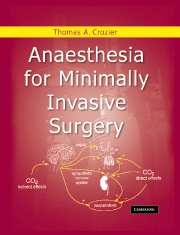Book contents
- Frontmatter
- Contents
- Preface
- Foreword
- Acknowledgements
- 1 Introduction
- 2 Physiology
- 3 Preparing and positioning for laparoscopic surgery
- 4 Monitoring
- 5 Anaesthesia for laparoscopic surgery
- 6 Complications and contraindications of laparoscopic surgery
- 7 Post-laparoscopy pain and pain relief
- 8 Laparoscopic bariatric surgery
- 9 Minimally invasive thoracic surgery
- 10 Laser surgery of the upper aerodigestive tract
- 11 Minimally invasive neurosurgery
- Index
4 - Monitoring
Published online by Cambridge University Press: 21 October 2009
- Frontmatter
- Contents
- Preface
- Foreword
- Acknowledgements
- 1 Introduction
- 2 Physiology
- 3 Preparing and positioning for laparoscopic surgery
- 4 Monitoring
- 5 Anaesthesia for laparoscopic surgery
- 6 Complications and contraindications of laparoscopic surgery
- 7 Post-laparoscopy pain and pain relief
- 8 Laparoscopic bariatric surgery
- 9 Minimally invasive thoracic surgery
- 10 Laser surgery of the upper aerodigestive tract
- 11 Minimally invasive neurosurgery
- Index
Summary
Monitoring for minimally invasive operations is essentially the same as for the conventional counterparts with basic monitoring of circulatory and respiratory parameters as well as surveillance of the correct functioning of the auxiliary support apparatus, such as ventilators, drug infusion equipment, etc. However, laparoscopic surgery forces a shift of emphasis to particular aspects of the monitoring spectrum, and mandates the inclusion of some parameters that might not be so crucial for the conventional procedures. Carbon dioxide (CO2) absorption and alterations of pulmonary function are the two characteristic features that come to mind. The primary aim of monitoring is, of course, to ensure the maximum safety for the patient, but in minimally invasive surgery there is an additional goal of helping to exploit the concept to its fullest extent.
Respiratory monitoring
Monitoring of oxygenation and ventilation is especially important during laparoscopic surgery, because, on the one hand, these functions are directly impaired by the operations themselves, and are additionally challenged by the uptake of CO2 on the other. Peripheral pulse oximetry and capnometry are usually adequate surrogate measures of arterial oxygen (O2) and CO2 tensions, although under some circumstances capnometry may be misleading (see below).
Oxygenation
Pneumoperitoneum and the head-down tilt tend to intensify the occurrence of atelectatic regions in the lung that appear after induction of anaesthesia in the supine patient, and to further increase venous admixture, widening the alveolar–arterial O2 difference (AaDO2) and increasing the risk of hypoxaemia during laparoscopic procedures.
- Type
- Chapter
- Information
- Anaesthesia for Minimally Invasive Surgery , pp. 45 - 54Publisher: Cambridge University PressPrint publication year: 2004



